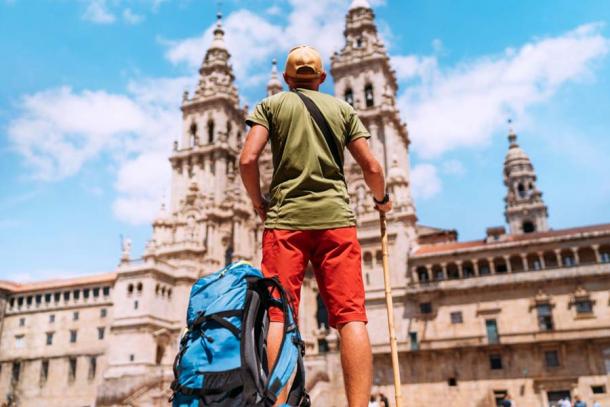Psychologists and religious leaders agree that the ancient Camino de Santiago is a great “way” to fight depression and mental health illnesses. The trail, whose English name translates into the “Way of St. James”, weaves through France and Spain and is a famous pilgrimage route which terminates in the alleged shrine of Saint James the Great . The shrine is now the Cathedral of Santiago de Compostela, in the capital of Spain’s northwestern Galicia region.
Since the 9th century, the Camino de Santiago has been a primary Catholic pilgrimage route and in 1985 the city’s historic city center was designated a UNESCO World Heritage Site. Now, after a year of being under lockdown, spiritual wanderers are fleeing cities all over the world and, with the worst of coronavirus behind them, they are flocking to the historic Camino de Santiago to heal.

Pilgrim arriving at the Cathedral of Santiago de Compostela, after walking the Camino de Santiago. ( Soloviova Liudmyla / Adobe Stock)
The Long Way to a Saint’s Soul
Consecrated in 1211 AD, the Cathedral of Santiago de Compostela is the traditional Catholic home of the body of Saint James, also known as James the Great. As the patron saint of Spain, according to the New Testament , James was the son of the Biblical Zebedee and one of the Twelve Apostles of Jesus. Perhaps the most iconic symbol of James, and of the Camino de Santiago, is the scallop shell. Historically members of the clergy gave pilgrims a scallop shell on their arrival at the city of Santiago de Compostela as a memento for having completed their pilgrimage to the holy site.
According to a recent report in ABC News “mental health experts assert that the pilgrimage can lead to emotional healing for both the devout and secular.” From ancient times to today, the scallop shell is used for drinking water from the springs and streams along the way. Committing to the pilgrim’s path has for centuries been a source of both physical and spiritual renewal for those willing to make some serious sacrifices.
The ABC article interviewed Laura Ferrón, who was recently divorced at the end of the Covid-19 lockdown. Fearing losing her job, she and two old friends recently walked the last 100 kilometers (62 miles) of the pilgrimage route in search of a new lease of life, far from the pain and suffering of her real world.

The scallop shell has become the symbol of the pilgrim walking the Camino de Santiago in Spain. ( JulianLogle / Adobe Stock)
Post-Covid Pilgrims Return to Spain
It is estimated that over 340,000 people walked the Camino de Santiago in 2019. This number fell to only 50,000 in 2020 after Spain closed its borders to foreign tourists. Furthermore, the Way was closed to Spaniards as well, except for during the summer in 2020. Now, it is expected that after Pope Francis extended the 2021 holy year dedicated to St. James through 2022, and with Covid-19 restrictions lifting, people will return to walk the Camino de Santiago en masse, effectively reactivating the ancient channel of spatial and physical wellbeing.
A recent article in Religious News said mental health experts agree that the act of pilgrimage can lead to “emotional healing for both faithful Roman Catholics ,” as well as all the non-Catholics who embark on the adventure. Dr. Albert Feliu, a health psychologist and lecturer at the Autonomous University of Barcelona, told Religious News that a recent survey of 100 pilgrims observed that they experienced “a reduction of stress and depression that surpass those seen after regular vacations.”

Backpacker walking through eucalyptus forest on the Camino de Santiago in Spain. ( Soloviova Liudmyla / Adobe Stock)
Trimming Down is the Way Ahead
Manu Mariño, the director of Quietud Mindfulness Center in Santiago, has walked the Camino de Santiago 24 times and he says it makes “you learn to live with just what is necessary, which means exactly what you can carry in a backpack.” Furthermore, Dr. Mariño said the pilgrimage was a very good place to help us realize that suffering forms part of life, and that our suffering depends on how we relate to what we are experiencing.
While the word c amino (meaning “way”) is all over the headlines today, neither the Pope or Dr. Mariño seem to have mentioned the word “walk,” even though the two are inseparable. Walking reduces stress and the mental health benefits are many. Increased cardiovascular and pulmonary (heart and lung) fitness leads to reduced risk of heart disease and stroke.
Furthermore, improved management of conditions such as hypertension (high blood pressure), high cholesterol, joint and muscular pain or stiffness, and diabetes, is gained only from a brisk stroll once a day. So walking the 805 km (500 mi) of the Camino de Santiago is a seriously good way to knock one’s mind and body into the best shape possible.
Top image: A pilgrim walking the Camino de Santiago in Spain. Source: maribom / Adobe Stock
By Ashley Cowie
 RSS Feed
RSS Feed















 June 8th, 2021
June 8th, 2021  Awake Goy
Awake Goy  Posted in
Posted in  Tags:
Tags: 













